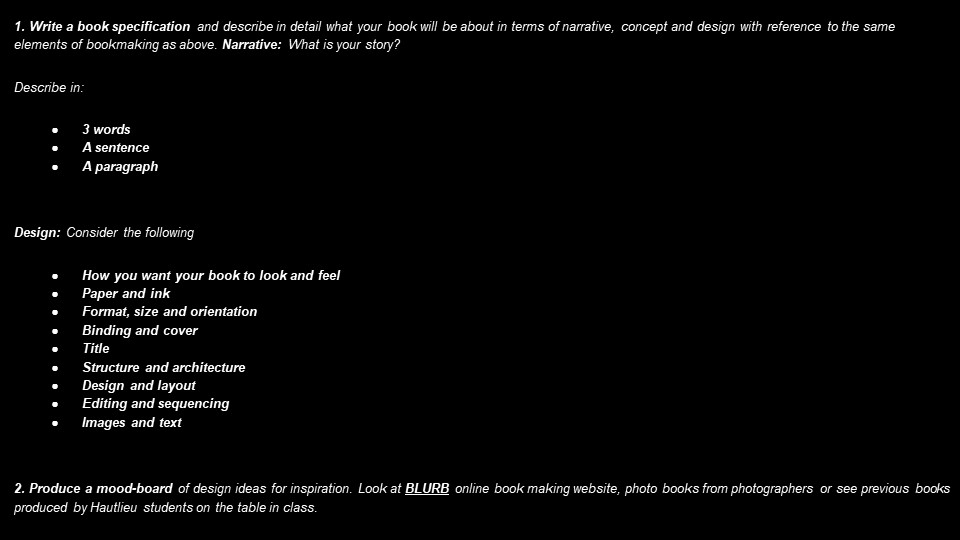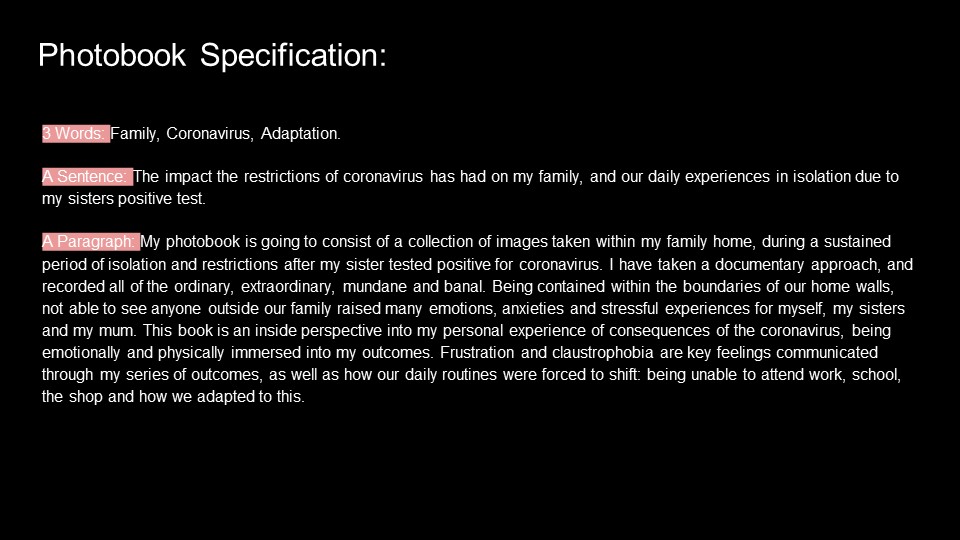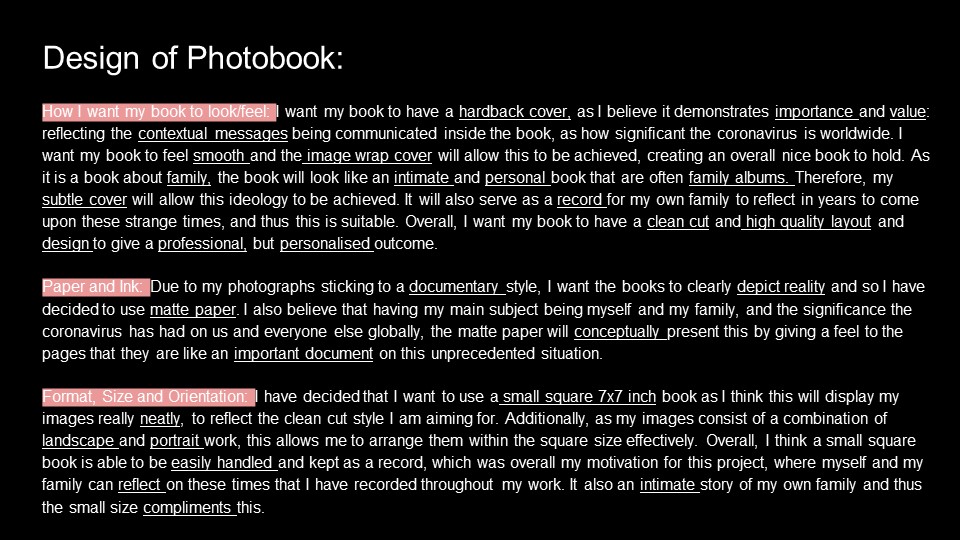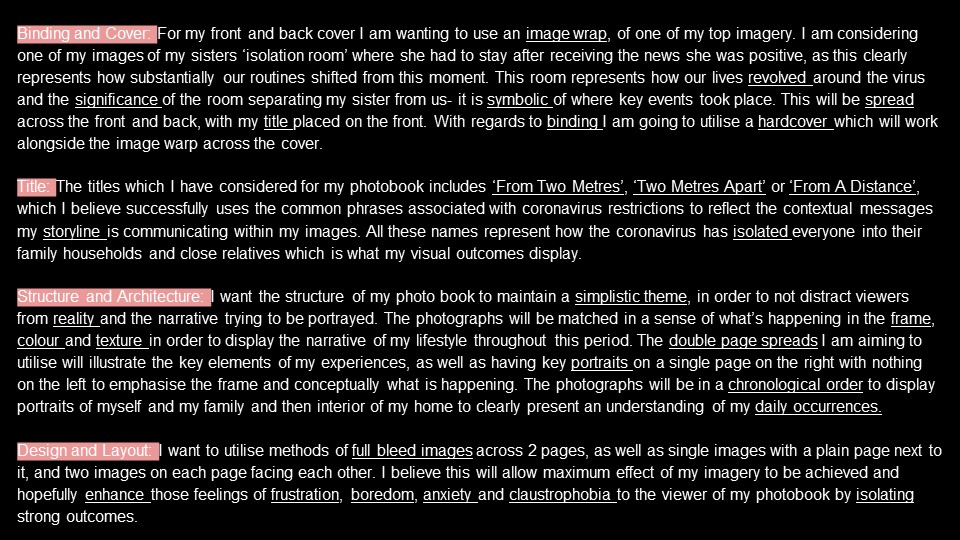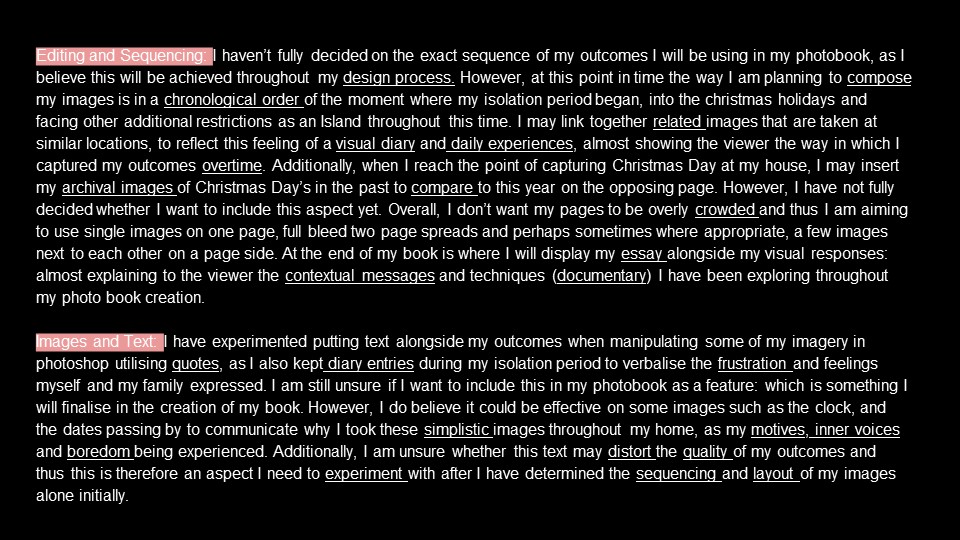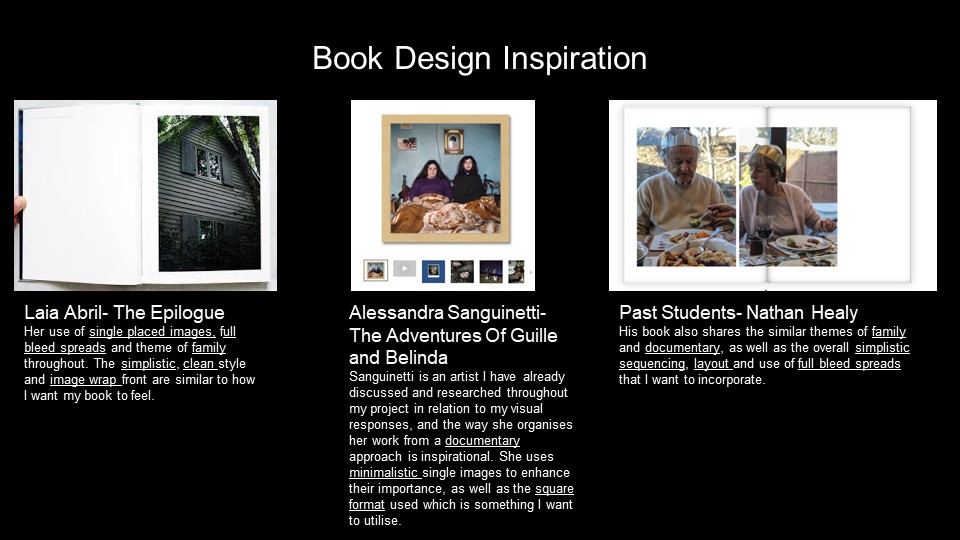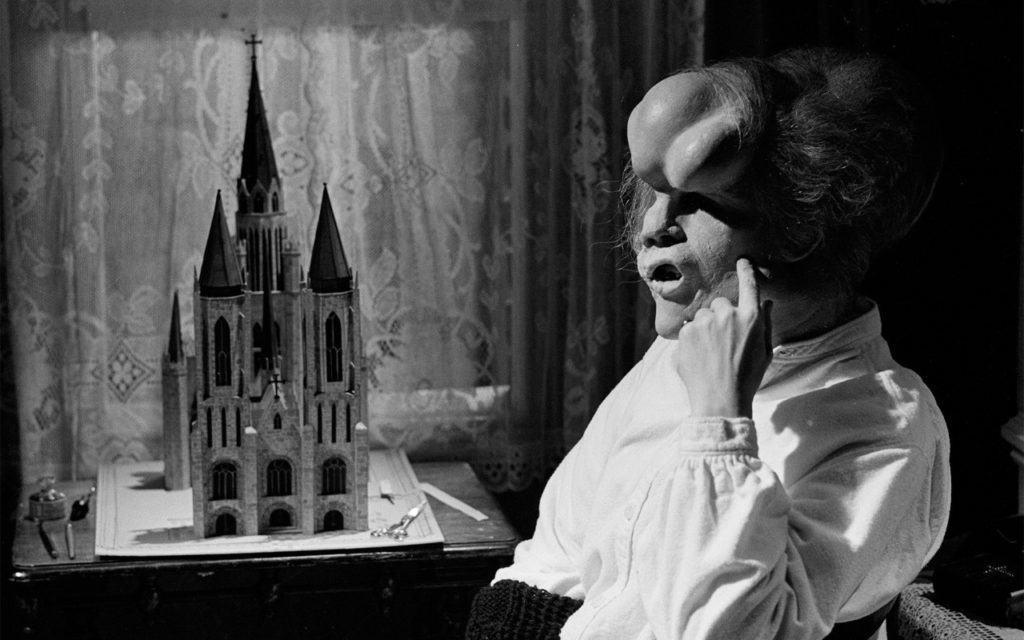Daily Archives: 20/01/2021
Filters
NARRATIVE – PLANNING MY PHOTO-BOOK
STORY: What is your story?
- 3 words : My personal diary
- A sentence : A range of photos from key events in my life 2020/2021.
- A paragraph : I am going to create my own personal photo diary, taking pictures of people I love as well as all the simple, mundane parts of my life. The photos will depict my forest memories, good and bad, that I would like to remember.
NARRATIVE: How will you tell your story?
SPECIFICATION
and describe in detail what your book will be about in terms of narrative, concept and design with reference to the same elements of bookmaking as above:
- How you want your book to look and feel. I would like the book to fell matte and smooth like ‘Diary’. It could possibly have a textured surface.
- Paper and ink. matte images and matte pages.
- Format, size and orientation.
- Binding and cover.
- Title : some of my ideas have been ‘dear diary’, or ‘dear future me’, but my favourite title has been ‘Dear, Liw’ which really focuses on who’s life my book is about; myself.
- Structure and architecture: random arrangement of images, jumbles dates. One image per page preferably, and all the images will be the same size. Most of the images will be edited in the same way to keep consistency and authenticity.
Design and layout. Editing and sequencing. There will be one image per page in the same orientation, mainly landscape and not portrait. Photos will rarely be in black and white. Images will mainly look like disposables (aiming to edit like Nan Goldin and Corinne Day). Random sequencing, what images look best together on opposing pages. All images will be mostly edited the same, I will try to not crop the images so they are as real to the scene I took a photo of.
Images. New photographic responses, photo-shoots. I will be taking photos on a daily basis of my friends and family. I plan for all of my images to be extremely candid. Due to the fact they will not be particularly planned, it gives a natural feel like a diary would and lets the audience feel like they’re in the moment with me. Old photos from family albums, iPhone. I may want to use photographs from 2020. Due to C19, I have not been able to see/ meet with friends and family like I would usually. I would like to use some images from 2020 t fill my book with lively events.
text. letters, documents, poems, text messages. These will caption each photograph in my book. There will be short caption to each image, explaining what the image is about, however I plan to write what makes sense to me; I’m not explaining the whole story, just what reminds me of the event/ experience. I also plan to scan through my own handwriting to caption each image, making it further seem like my own diary. I could include ‘souvenirs’ from days such as tickets and wrappers, letters etc.
2. Produce a mood-board of design ideas for inspiration. Look at BLURB online book making website, photo books from photographers or see previous books produced by Hautlieu students on the table in class:

images will include things like:
- washing my own first car
- practicing driving for the first time
- going on family walks
- going to friends
- meeting with my boyfriend
- cool images that I find interesting
first edits
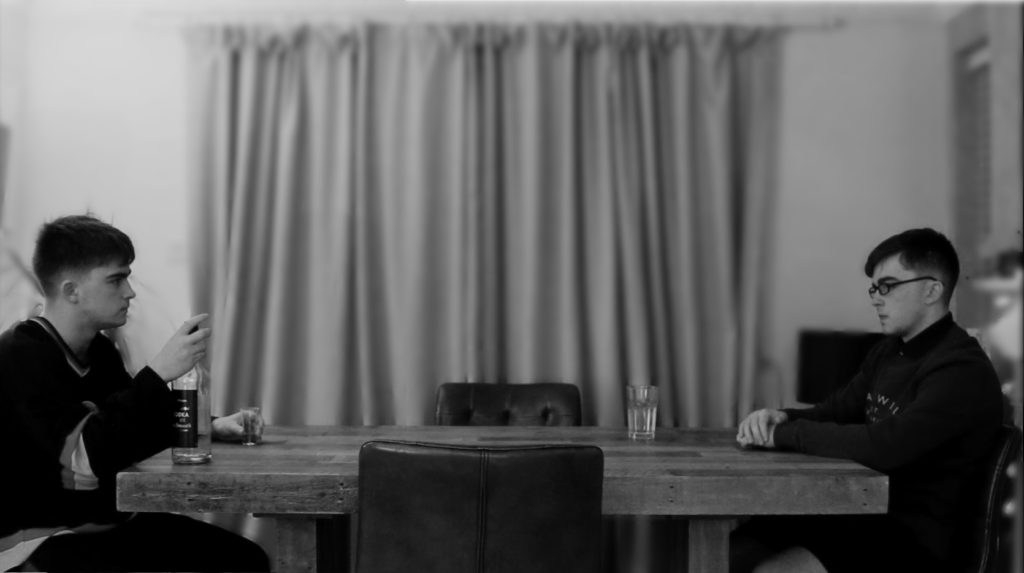




David Lynch – Director of Dreams
The First Famous Surrealist – Pauline Kael
“We think we understand the rules when we become adults but what we really experience is a narrowing of the imagination.”
― David Lynch
Gripping the audiences imagination is one of Lynch’s true talents when it comes to the film industry. Although he started off as an artist, his artistic skills contribute to his films and they start to make more sense when you remember where he started. Most of his film have very little dialogue and if they do it’s because its used more as poetry and each line has a purpose and specific meaning. Similar to how he frames each scene; each one is framed a certain way and creates a particular feeling with the viewers and often it leaves them mildly disturbed. Being one the biggest contributors to surrealist film industry, you would think that Lynch’s work would be fairly mainstream although it is quite the opposite. Although he is mostly a film maker now he felt as if he wanted to be known more as an artist, who typically won’t be as well known as a film maker. His most famous film (his debut film), Eraserhead, still stands as a benchmark in surrealist horror, and Lynch would go on to define surrealism in film through his later works Blue Velvet, Twin Peaks, Lost Highway, Mulholland Drive and Inland Empire. But what gives Lynch’s strange masterworks their strange ominous feeling upon his fans and longevity is his keen artistic eye; his fascination with the light and dark of American life, and his brilliant command of unique character and melodrama. It’s a powerful and heady combination of strange and amazing; a combination that has earned David Lynch a legion of devoted fans and earned him a place as one of the greatest filmmakers in history.
Inspiration: Francis Bacon
At the beginning of David Lynch’s Career he found inspiration through the famous and wealthy, Francis Bacon was an Irish figurative painter, who was influenced in his earlier years by Picasso and surrealism. His most expensive painting was a staggering $142 million! His unique expressionist and deeply disturbing style of painting, which emerged during the 1950s, featured pictures of people screaming or in pain and often portrayed inside bathrooms or cages. Arguably this painter of the twentieth century, was also for forty years the most controversial. Bacon’s art often appears deliberately disturbing. His subject was the human form. Bacon reinterpreted the physical construction of the body with a new and unsettling intensity. To him it was something to be taken apart by the artist’s penetrating gaze and then put back together again on canvas. He forces us to see, perhaps for the first time, the separate shapes and stresses hidden in the familiar human figure. The way Bacon painted his faces could be especially challenging. In his portraits, generally of people the artist knew well, the subjects are sometimes shown screaming. Due to his paintings, he was often called an Expressionist or even a Surrealist, Bacon himself strongly rejected both labels. He insisted that in its own way his work was close to the world we see every day, remaining true to what he called “the brutality of fact.”
Surrealism was a movement in literature and art, that now links in to photography and film making, which was popular between the First and Second World Wars. It was founded by the poet André Breton and the movement emphasised the importance of unconscious thought as a starting-point for creativity, inspired by the work of Sigmund Freud. Surrealist artworks are signified by their juxtaposition of incongruous imagery and figurative, typically photo-realistic style.



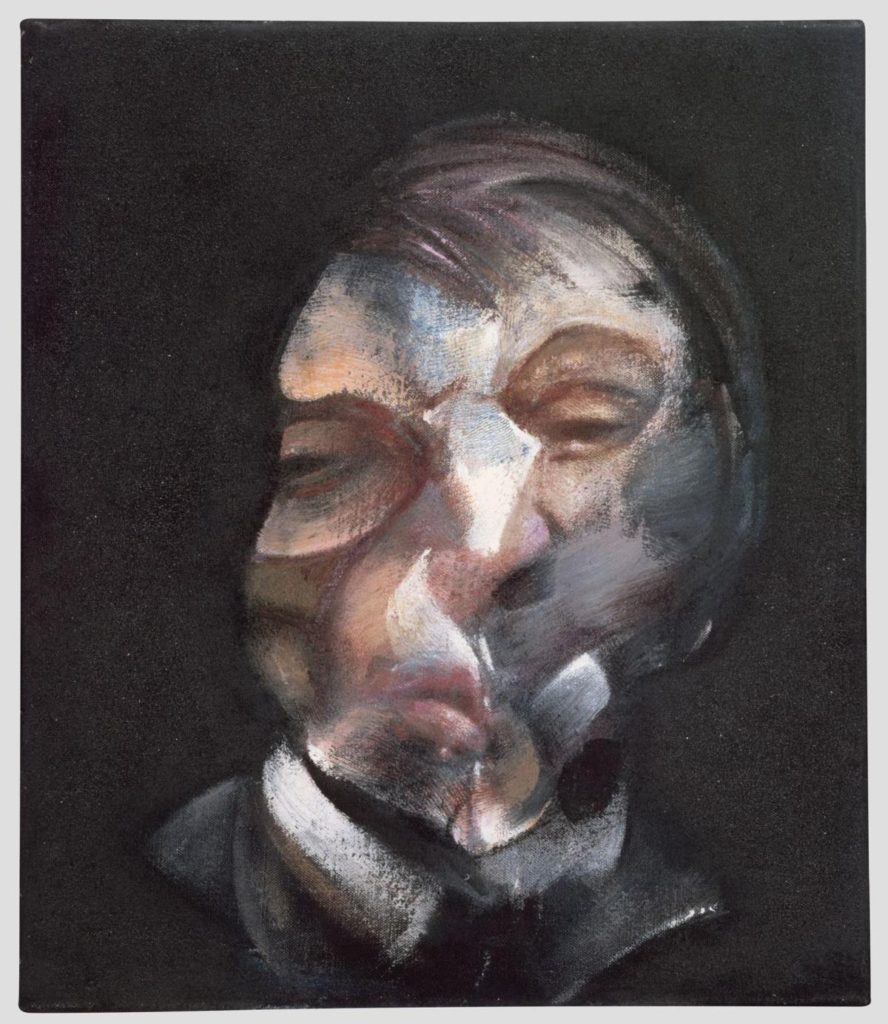


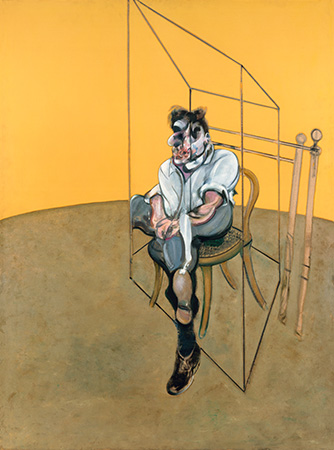
Three Studies of Lucian Freud


